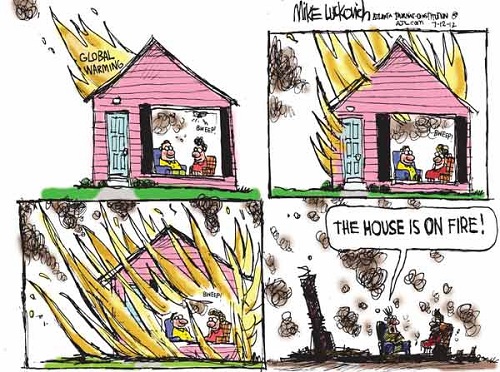2012 SkS Weekly Digest #30
Posted on 30 July 2012 by John Hartz
SkS Highlights
With Climate Change Cluedo: Anthropogenic CO2, Tom Curtis has created a new template for future SkS articles based on the board game of Cluedo(Clue in the US). In this article, Curtis sets forth ten main lines of evidence that humans have caused the rise in CO2 levels since the beginning of the 20th Century by burning fossil fuels. Every other hypothesis makes a host of predictions that do not pass the test of the evidence.
Toon of the Week

Cartoon by Mike Luckovich
Quote of the Week
"Last year, following an intensive research effort involving a dozen scientists, I concluded that global warming was real and that the prior estimates of the rate of warming were correct. I’m now going a step further: Humans are almost entirely the cause." - Richard Muller
Source: The Conversion of a Climate-Change Skeptic, New York Times, July 28, 201
Issue of the Week
When is the last time that you have visited the SkS Facebook page? Have you "liked" the SKS Facebook page?
Scientific Term of the Week
Energy balance: The difference between the total incoming and total outgoing energy. If this balance is positive, warming occurs; if it is negative, cooling occurs. Averaged over the globe and over long time periods, this balance must be zero. Because the climate system derives virtually all its energy from the Sun, zero balance implies that, globally, the amount of incoming solar radiation on average must be equal to the sum of the outgoing reflected solar radiation and the outgoing thermal infrared radiation emitted by the climate system. A perturbation of this global radiation balance, be it anthropogenic or natural, is called radiative forcing.
Source: Annex I (Glossary) to Climate Change 2007: Working Group I: The Physical Science Basis, IPCC Fourth Assessment Report.
The Week in Review
A complete listing of the articles posted on SkS during the past week.
- Peter Hadfield takes on the MWP by Rob Honeycutt
- Unprecedented Greenland Ice Sheet Surface Melt by Neven
- Mann Fights Back Against Denialist Abuse by Dana
- Mercury - The Hidden Danger of Arctic Warming? by Steve Brown
- Tar Sands Oil - An Environmental Disaster by Dana
- Climate Change Cluedo: Anthropogenic CO2 by Tome Curtis
- New research special - satellite measurement papers 2010-2011 by Ari Jokimäki
Coming Soon
A list of articles that are in the SkS pipeline. Most of these articles, but not necessarily all, will be posted during the week.
- New research special - paleoclimate papers 2010-2011 (Ari Jokimäki)
- Lindzen's Sandia Talk Contains his Usual Glaring Errors (Dana)
- Is Greenland close to a climate tipping point? (James Wight)
- BEST Results Consistent on Human-Caused Global Warming (Dana)
- Skeptic Magazine vs. Heartland and Monckton Cherrypicked Denialism (AlexC and Dana)
- Nature has invented the ideal method to sequester carbon: coal (Sarah)
- The Continuing Denial of the Scientific Consensus on Climate Change (Andy S)
SkS in the News
Dana's Vision Prize Results was featured by the Vision Prize.
SkS Spotlights
The Walker Institute for Climate System Research was established at the University of Reading in Autumn 2006.
It draws together a number of internationally renowned climate system research groups and centres with expertise across a wide range of core disciplines central to climate system science.
Our vision is to be a world leader in integrated climate system research in order to deliver better knowledge and understanding of future climate and its impacts for the benefit of society.































 Arguments
Arguments























 0
0  0
0






Comments